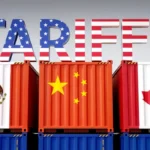Latest Posts
June 30, 2025 Tariffs: The Upside
June 30, 2025
Tariffs: The Upside
June 30, 2025
 Exploring the Role of Intrapreneurs: Innovation Drivers Within Organizations
June 30, 2025
Exploring the Role of Intrapreneurs: Innovation Drivers Within Organizations
June 30, 2025
 Mastering Productivity: A Guide to Being More Effective While Working from Home
Mastering Productivity: A Guide to Being More Effective While Working from Home
Newsletter
Sign up to receive email updates from the Freightpath.
"*" indicates required fields
Harmonizing Intelligence: How Supply Chain Professionals Can Thrive Alongside AI
June 30, 2025
In a world increasingly defined by algorithms and automation, the relationship between human expertise and artificial intelligence (AI) is no longer a speculative conversation but an immediate reality. Nowhere is this more apparent than in the realm of supply chain management, where AI is not only streamlining operations but also reshaping job roles and strategic decision-making. Rather than viewing AI as a threat to job security or professional relevance, supply chain experts have a unique opportunity to evolve alongside it, creating a partnership that enhances both efficiency and human impact.
Supply chain management has always been a blend of logistics, intuition, and analytical prowess. From forecasting demand to managing inventory, routing deliveries, and negotiating with suppliers, it demands both precision and flexibility. AI brings powerful tools to the table: the ability to process enormous datasets in real time, identify patterns invisible to the human eye, and make predictive recommendations at speed. But even with all this capability, AI lacks the nuanced judgment, relationship-building finesse, and ethical reasoning that human professionals bring to the field.
The key to thriving alongside AI is understanding that the technology is an augmentation, not a replacement. Just as calculators didn’t eliminate the need for mathematicians and autopilot systems didn’t make pilots obsolete, AI in supply chains is best viewed as a force multiplier. It allows professionals to focus on higher-value tasks by automating the routine and augmenting decision-making with data-driven insights.
One of the most immediate ways AI supports supply chain professionals is in demand forecasting. Traditional methods rely heavily on historical data and static models. AI introduces dynamic modeling that adapts in real time to changing market conditions, social trends, weather patterns, and global events. This means forecasts are not just more accurate, but also more adaptable. For professionals, this translates into the ability to plan more confidently, reduce waste, and respond to volatility with agility. AI becomes a partner in crafting strategies, not merely crunching numbers.
Inventory management also benefits significantly from AI integration. Algorithms can predict optimal stock levels, suggest replenishment schedules, and even anticipate supplier delays based on historical trends and current events. With AI handling these calculations, professionals can turn their attention to supplier relationships, contract negotiations, and sustainability initiatives. The result is a shift from reactive problem-solving to proactive value creation.
AI is also revolutionizing logistics through route optimization and real-time tracking. By factoring in traffic, weather, fuel costs, and delivery constraints, AI systems can devise the most efficient transportation plans. But the final say often remains with human operators who must consider customer-specific requirements, service levels, and unexpected disruptions. Here, AI acts as a co-pilot—providing options and data but leaving the ultimate decisions to seasoned professionals.
Perhaps one of the most transformative aspects of AI in supply chains is its potential to elevate strategic planning. Scenario modeling, risk assessment, and trend analysis powered by machine learning can uncover opportunities and vulnerabilities far beyond the scope of traditional spreadsheets. Human insight is essential to interpret these findings in context, balancing quantitative outputs with qualitative factors like corporate values, market perception, and long-term vision. This is where the future of supply chain leadership lies: not in manual oversight of processes, but in orchestrating strategy informed by AI.
The coexistence of AI and human talent also hinges on continual learning and adaptability. As AI tools become more embedded in supply chain systems, professionals must cultivate digital fluency. This doesn’t mean becoming data scientists or coders, but rather developing a working understanding of how AI operates, what it can and cannot do, and how to ask the right questions of the systems. Organizations should support this evolution through training programs, mentorship, and a culture that celebrates curiosity and growth.
Moreover, emotional intelligence and communication skills are taking center stage. AI may generate insights, but translating those insights into action requires human connection. Supply chain professionals who can explain complex data in clear, relatable terms, persuade stakeholders, and build consensus will become increasingly indispensable. As AI handles the technical layers, the human role will revolve more around leadership, ethics, and empathy—qualities that machines cannot replicate.
There’s also a vital role for professionals in ensuring ethical AI deployment. Algorithms are only as unbiased and fair as the data and parameters fed into them. Humans must oversee AI systems to prevent discriminatory outcomes, ensure transparency, and align outputs with corporate responsibility goals. This stewardship role is not just necessary but profoundly valuable, placing human judgment at the heart of technological progress.
The integration of AI into supply chain management is not a destination but a journey—one that requires thoughtful navigation. It’s important to remember that coexistence is not about compromise, but about complementarity. When professionals embrace AI as a collaborator, they gain access to tools that amplify their impact and open new dimensions of value.
As this new era unfolds, stories of successful human-AI collaboration are emerging across industries. A procurement manager who uses AI to identify supplier risks before they escalate. A warehouse supervisor who leverages robotics to improve worker safety while reducing turnaround times. A logistics coordinator who uses predictive analytics to delight customers with faster, more reliable service. These are not futuristic fantasies; they are happening now, and they reflect the limitless potential of a well-balanced partnership.
Ultimately, the question is not whether AI will change the supply chain profession—it already has. The real question is how professionals will choose to respond. By leaning into what makes us uniquely human—our creativity, empathy, judgment, and drive—we can ensure that the rise of AI is not a replacement, but a renaissance. A chance to do our work not just differently, but better.
In this shared future, supply chain professionals will not be overshadowed by machines but illuminated by them, standing taller with the support of tools that extend their reach, enrich their perspective, and empower their choices. Coexistence with AI is not only possible—it is the most promising path forward for a stronger, smarter, and more sustainable supply chain ecosystem.
John Delgado
CEO @ FreightPath Inc. | CSCMP Corporate Member | We Deploy The Industry’s Most Comprehensive Global Supply Chain Curriculum | 500+ Course Library | gofreightpath.com/course-catalog
